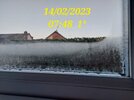- Joined
- 1 Mar 2023
- Messages
- 4
- Reaction score
- 0
- Country

We have a detached bungalow with loft conversion which has been suffering from condensation and had a PIV system installed which included a roof vent for the air intake as the reduced loft space due to the loft conversion was deemed to be inadequate,diffusers were installed on the upstairs hallway and one in the entrance hall ceiling, after a period of three months the system failed to make any impact on the problem.The front elevation of the house faces Westerly and gets the cold wind mostly from that direction,the double glazing was not up to current spec so at an additional expense the glazed units were replaced (£1100) in the hope that condensation would now not form,sadly it made only reduced but still present condensation 1cm water droplets along the bottom edge of the windows.
The installers have now removed the system and refunded.a dehumidifier is now in use and humidity levels have dropped from 60°+ to low 50°s and no more condensation even at low outside temps.
My analysis is the house is to airtight for a PIV system to work.
Full up to current spec D/Glazing
No open fireplace/chimney
Insulation between ceiling and upper floor.
Kingspan isulation to upstairs ceiling and walls.
A continuous fan is installed in the downstairs toilet/ shower room.
The installers have now removed the system and refunded.a dehumidifier is now in use and humidity levels have dropped from 60°+ to low 50°s and no more condensation even at low outside temps.
My analysis is the house is to airtight for a PIV system to work.
Full up to current spec D/Glazing
No open fireplace/chimney
Insulation between ceiling and upper floor.
Kingspan isulation to upstairs ceiling and walls.
A continuous fan is installed in the downstairs toilet/ shower room.
Last edited:

